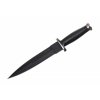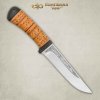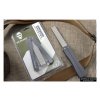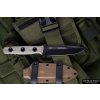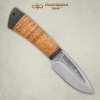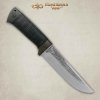When you choosing a knife, which can be folding or fixed, hunting or fishing, urban EDC or tactical, camping or survival knife, you must first pay special attention to the type of steel used on the blade. Along with the geometry and design of the blade, the blade material is the critical element that determines how the knife will perform.
1) REMAINING ELEMENTS OF STEEL ALLOYS
Primitively speaking, steel is an alloy of iron with carbon. If there is too much carbon, then cast iron is obtained. If too little, then it is called tin. Anything in between can be called steel. Its various types are determined not only and not so much by the proportions of iron and carbon, but by alloying with various additives and impurities that give different properties to steel.
Carbon: Present in all types of steels as a basic element that imparts hardness and rigidity. Most often we expect a carbon content of more than 0.5% from steel (these are the so-called high-carbon steels)
Manganese: An important element of the alloy, it gives the metal a grain structure, and contributes to the strength of the blade, as well as rigidity and wear resistance. It is used to improve steel during rolling and forging (so-called "deoxidized steel"). Present in all blade steel alloys except types A-2, L-6, and CPM 420V.
Chromium: gives the alloy wear resistance, hardenability, and most importantly, corrosion resistance. Steel with a content of at least 13% chromium is called "stainless". Although, despite this name, any steel can corrode if not cared for properly.
Molybdenum: a hard-melting element, prevents blade brittleness and brittleness, gives resistance to heat. Present in many alloys. The so-called "air hardened" steels contain at least 1% molybdenum, which makes this type of hardening possible.
Nickel: Used for hardness and corrosion resistance as well as alloy toughness. Present in steels L-6, as well as in AUS-6 and AUS-8.
Silicon: Used for the strength of the blade. Just like manganese, it is used in blade forging.
Tungsten: gives the blade a wear resistance. When combined with chromium or molybdenum, tungsten makes steel "high speed". This steel grade M-2 has the highest tungsten content. Also used in the manufacture of tank armor
Vanadium: contributes to wear resistance and strength. Hard-melting element of increased hardness, which is necessary in the manufacture of fine-grained steel. Many alloys contain vanadium, but its highest content is in the M-2, Vascowear grades, as well as CPM T440V and 420V (in decreasing order of vanadium content). Steel BG-42 differs from steel ATS-34 mainly in the addition of vanadium.
2) STAINLESS STEEL
Remember that any steel can rust. But the so-called "stainless" steels, due to the addition of at least 13% chromium, have significant resistance to corrosion. At the same time, it should be noted that one percentage of chromium is still not enough for the recognition of steel as belonging to the category of "stainless". In the knife industry, the de facto standard is 13% chromium, but the ASM metal guide says "more than 10%" is sufficient; other sources set their own quantitative boundaries. We add that alloying elements are strongly influenced by the chromium content; a lower proportion of chromium with properly selected other impurities can give the same "stainless steel" effect.

